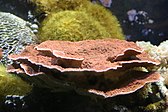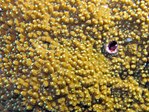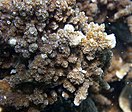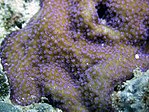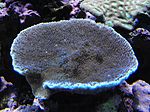Montipora
| Montipora | |
|---|---|

| |
| Montipora aequituberculata | |
| Scientific classification | |
| Domain: | Eukaryota |
| Kingdom: | Animalia |
| Phylum: | Cnidaria |
| Class: | Hexacorallia |
| Order: | Scleractinia |
| Family: | Acroporidae |
| Genus: | Montipora Blainville, 1830[1][2] |
| Synonyms[1] | |
| |
Montipora is a genus of Scleractinian corals in the phylum Cnidaria. Members of the genus Montipora may exhibit many different growth morphologies. With eighty five known species,[1] Montipora is the second most species rich coral genus after Acropora.[3]
Description

Growth morphologies for the genus Montipora include submassive, laminar, foliaceous, encrusting, and branching.[4][5] It is not uncommon for a single Montipora colony to display more than one growth morphology.[5] Healthy Montipora corals can be a variety of colors, including orange, brown, pink, green, blue, purple, yellow, grey, or tan.[5] Although they are typically uniform in color, some species, such as Montipora spumosa or Montipora verrucosa, may display a mottled appearance.[5]
Montipora corals have the smallest corallites of any coral family.[5] Columellae are not present.[5] Coenosteum and corallite walls are porous, which can result in elaborate structures.[5] The coenosteum of each Montipora species is different, making it useful for identification.[5] Polyps are typically only extended at night.[5]
Montipora corals are commonly mistaken for members of the genus Porites based on their visual similarities, however, Porites can be distinguished from Montipora by examining the structure of the corallites.[5]
Distribution
Montipora corals are common on reefs and lagoons of the Red Sea, the western Indian Ocean and the southern Pacific Ocean, but are entirely absent in the Atlantic Ocean.[4]
Ecology
Montipora corals are hermaphroditic broadcast spawners.[6] Spawning typically happens in spring.[6] The eggs of Montipora corals already contain zooxanthellae, so none is obtained from the environment.[6][7] This process is known as direct or vertical transmission.[3]
Montipora corals are preyed upon by corallivorous fish, such as butterflyfish.[8] Montipora corals are known to host endo- and ectoparasites such as Allopodion mirum and Xarifia extensa.[1] A currently undescribed species of nudibranch in the genus Phestilla has also been reported in the scientific and aquarium hobbyist literature to feed on the genus.[9]
Montipora corals are susceptible to the same stresses as other Scleractinian corals, such as anthropogenic pollution, sediment, algal growth, and other competitive organisms.[6]
Evolutionary history
A 2007 study found that the genus Montipora formed a strongly supported clade with Anacropora, making it the genus with the closest genetic relationship to Montipora.[10] It is thought that Anacropora evolved from Montipora relatively recently.[7]
Gallery
-
Montipora capricornis
-
Polyps of Montipora aequituberculata
-
Montipora aequituberculata colonies near Ningaloo Reef
-
Montipora caliculata
-
Branching colony of Montipora capitata in Hawaii
-
Encrusting colony of Montipora capitata
-
Polyps of Montipora danae
-
Montipora ehrenbergii
-
Montipora hispida
-
Polyps of Montipora hispida
-
Polyps of Montipora monasteriata
-
Montipora nodosa
-
Montipora tuberculosa
-
Montipora verrucosa at Birch Aquarium in San Diego, CA
Species
- Montipora aequituberculata Bernard, 1897
- Montipora altasepta Nemenzo, 1967
- Montipora angulata Lamarck, 1816
- Montipora aspergillus Veron, DeVantier & Turak, 2000
- Montipora australiensis Bernard, 1897
- Montipora biformis Nemenzo, 1988
- Montipora cactus Bernard, 1897
- Montipora calcarea Bernard, 1897
- Montipora calculata Dana, 1846
- Montipora capitata Dana, 1846
- Montipora capricornisVeron, 1985
- Montipora cebuensis Nemenzo, 1976
- Montipora circumvallata Ehrenberg, 1834
- Montipora cocosensis Vaughan, 1918
- Montipora confusa Nemenzo, 1967
- Montipora conspicua Nemenzo, 1979
- Montipora contorta Nemenzo & Montecillo, 1981
- Montipora corbettensis Veron & Wallace, 1984
- Montipora crassituberculata Bernard, 1897
- Montipora cryptus Veron, 2000
- Montipora danae Milne Edwards & Haime, 1851
- Montipora delicatula Veron, 2000
- Montipora digitata Dana, 1846
- Montipora dilatata Studer, 1901
- Montipora echinata Veron, DeVantier & Turak, 2000
- Montipora edwardsi Bernard, 1897
- Montipora efflorescens Bernard, 1897
- Montipora effusa Dana, 1846
- Montipora ehrenbergi Verrill, 1872
- Montipora explanata Brüggemann, 1879
- Montipora flabellata Studer, 1901
- Montipora florida Nemenzo, 1967
- Montipora floweri Wells, 1954
- Montipora foliosa Pallas, 1766
- Montipora foveolata Dana, 1846
- Montipora friabilis Bernard, 1897
- Montipora gaimardi Bernard, 1897
- Montipora gracilis Klunzinger, 1879
- Montipora grisea Bernard, 1897
- Montipora hemispherica Veron, 2000
- Montipora hirsuta Nemenzo, 1967
- Montipora hispida Dana, 1846
- Montipora hodgsoni Veron, 2000
- Montipora hoffmeisteri Wells, 1954
- Montipora incrassata Dana, 1846
- Montipora informis Bernard, 1897
- Montipora kellyi Veron, 2000
- Montipora lobulata Bernard, 1897
- Montipora mactanensis Nemenzo, 1979
- Montipora malampaya Nemenzo, 1967
- Montipora maldivensis Pillai & Scheer, 1976
- Montipora manauliensis Pillai, 1967
- Montipora meandrina Ehrenberg, 1834
- Montipora millepora Crossland, 1952
- Montipora mollis Bernard, 1897
- Montipora monasteriata Forskåi, 1775
- Montipora niugini Veron, 2000
- Montipora nodosa Dana, 1846
- Montipora orientalis Nemenzo, 1967
- Montipora pachytuberculata Veron, DeVantier & Turak
- Montipora palawanensis Veron, 2000
- Montipora patula Verrill, 1870
- Montipora peltiformis Bernard, 1897
- Montipora porites Veron, 2000
- Montipora samarensis Nemenzo, 1967
- Montipora saudii Veron, DeVantier & Turak
- Montipora setosa Nemenzo, 1976
- Montipora sinuosa Pillai & Scheer, 1976
- Montipora spongiosa Ehrenberg, 1834
- Montipora spongodes Bernard, 1897
- Montipora spumosa Lamarck, 1816
- Montipora stellata Bernard, 1897
- Montipora stilosa
- Montipora suvadivae Pillai & Scheer, 1976
- Montipora taiwanensis Veron, 2000
- Montipora tortuosaDana, 1846
- Montipora tuberculosa Lamarck, 1816
- Montipora turgescens Bernard, 1897
- Montipora turtlensis Veron & Wallace, 1984
- Montipora undata Bernard, 1897
- Montipora venosa Ehrenberg, 1834
- Montipora verrilli Vaughan, 1907
- Montipora verrucosa Lamarck, 1816
- Montipora verruculosa Veron, 2000
- Montipora vietnamensis Veron, 2000
References
- ^ a b c d World Register of Marine Species link: Montipora Blainville, 1830 (+species list)
- ^ "Montipora". Integrated Taxonomic Information System.
- ^ S2CID 86657478.
- ^ S2CID 85602339.
- ^ a b c d e f g h i j Veron, J.E.N (1986). Corals of Australia and the Indo-Pacific. London: Angus & Robertson Publishers. pp. 92–121.
- ^ a b c d Richmond, Robert (1997). Reproduction and Recruitment in Corals. pp. 175–197.
- ^ PMID 18517306.
- S2CID 34270212.
- ^ Fritts-Penniman, Allison Louise (2016). "Ecological Speciation and Cryptic Diversity of Coral-Associated Nudibranchs". UCLA. Retrieved 21 June 2019.
- S2CID 25263905.

